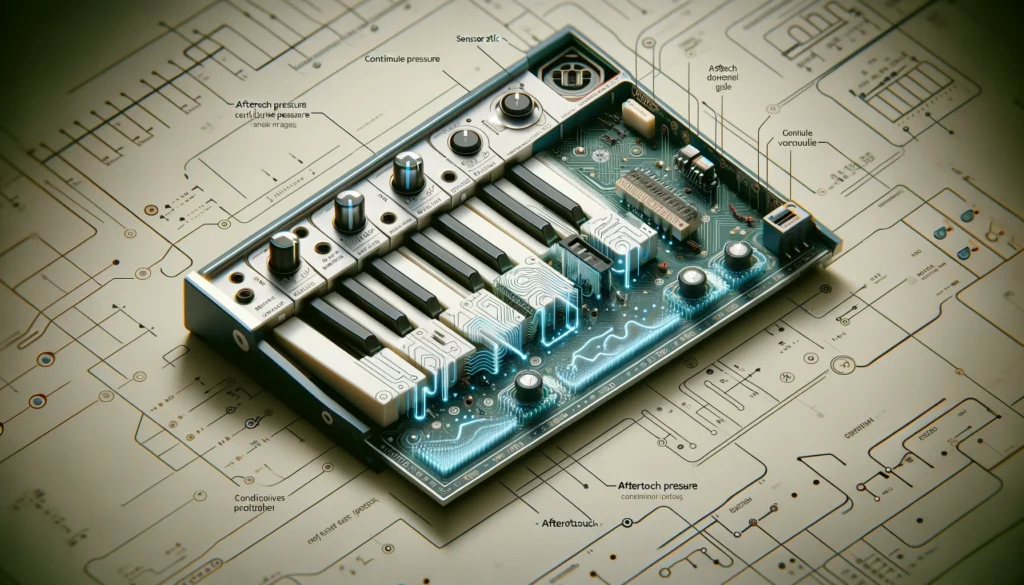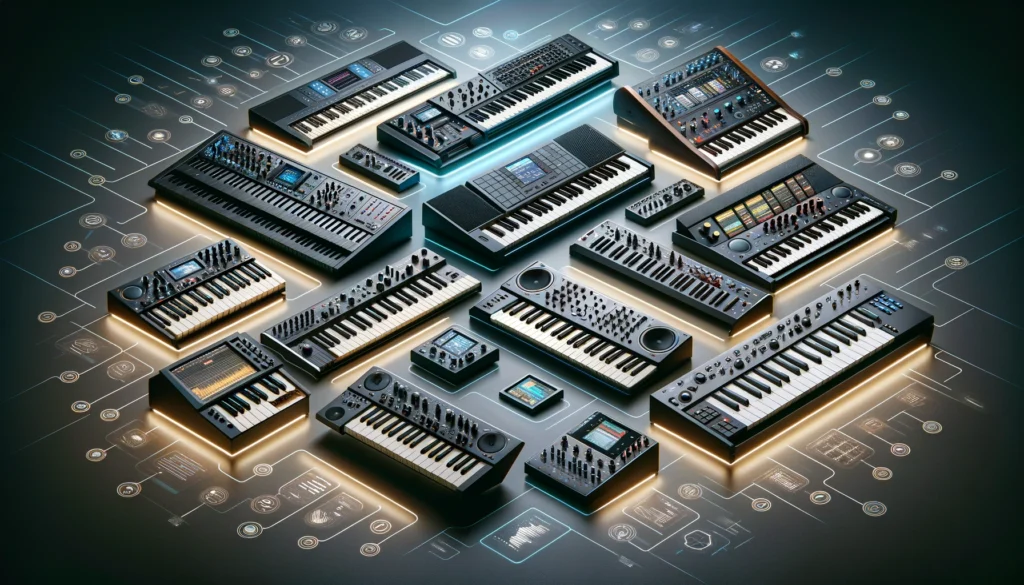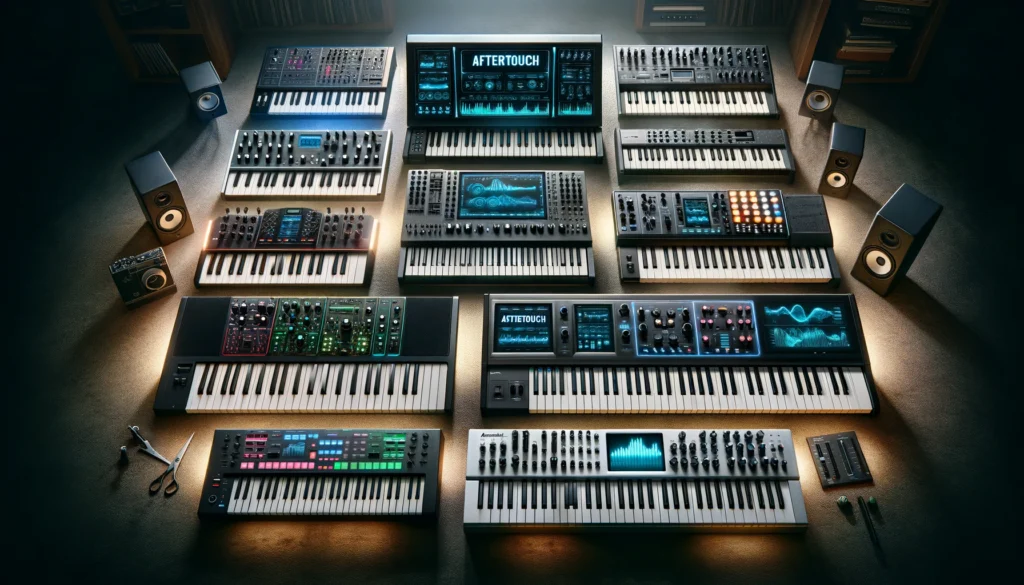Have you ever listened to a violinist add vibratos and swelling crescendos and wished your keyboard could capture that same expressiveness?
Or marveled at a jazz pianist who could subtly bend notes and change attack? Well, keyboard aftertouch may be the answer.
Let’s dive in to unlock these advanced playing techniques for your productions with this complete guide.
What is an Aftertouch MIDI Controller?

In simple terms, an aftertouch MIDI controller refers to a keyboard mechanism or external device that allows for continuous sensing of pressure on keys, even after the initial playing note velocity is struck.
This enables enhanced expression using piano-style keyboards, giving capabilities like pitch bends, swells, and vibrato effects.
We’ll explore the types, uses, and implementation options in more detail below.
What is Aftertouch?

Aftertouch refers to an extra dimension of expression that can be added to electronic keyboards and MIDI controllers.
It involves sensing the pressure that is applied to a key after the initial key strike.
So, after the initial velocity of pressing a key is detected, aftertouch allows for continuous measurement of extra downward pressure on that same key over time.
There are two main types of aftertouch: channel aftertouch (also known as mono aftertouch) and polyphonic aftertouch.
Channel aftertouch can measure the overall pressure being applied across the whole keyboard.
So pressing down harder on any of the keys will give the same continuous controller message.
Polyphonic aftertouch is a more advanced implementation that allows for sensing pressure on each individual key independently.
The data from the aftertouch sensors can be used to add modulation, vibrato, or other changes to the sound over time, allowing for extra expression and imitating various instrumental playing techniques.
For example, aftertouch messages are often mapped to control volume or brightness, allowing sounds to swell or get brighter the harder the key is pressed.
How Aftertouch Controllers Work

Keyboards and controllers with aftertouch capabilities have physical sensors integrated into the key mechanisms that are designed to detect changes in downward pressure after the initial key strike velocity is sensed.
A variety of sensor types are used by different keyboard manufacturers to achieve this pressure and release time measurement.
Common implementations involve things like contact strips, conductive rubber pads, or specialized strain gauges integrated into the spring assembly of each key’s mechanism.
These assembly variations allow the keys to send both the initial velocity MIDI message on the key strike as well as variable continuing pressure messages until the key is released.
The physical pressure detection is converted into MIDI data using a circuit embedded in the keyboard.
Aftertouch messages are sent as MIDI Control Change messages which are defined to communicate continuous controller data.
These messages are defined to send values between 0 (no pressure) and 127 (maximum pressure).
The rate at which this aftertouch data is sent can be adjusted, but it allows essentially real-time modulation data to be sent to MIDI sound sources and synthesizers.
These synths and sound modules can then be configured to modulate parameters like volume, vibrato, filter brightness and more based on the incoming aftertouch messages.
Uses of Aftertouch

Aftertouch opens up more expressive possibilities compared to basic on/off velocity-sensitive keyboards.
The extra layer of control allows for emulating various instrumental playing techniques and adding modulation effects like vibrato.
For example, aftertouch messages are often mapped to control pitch.
Pressing down harder on a key can trigger a vibrato effect, similar to violinists and guitarists bending notes for expression.
Aftertouch information can also be used to control volume swell and brightness of sounds over time.
This allows keyboard players to add extra emotion and feeling, similar to wind and brass instrumentalists adding expressiveness by changing breath pressure and embouchure tightness while sustaining notes.
Beyond just volume and pitch changes, creative sound designers also utilize polyphonic aftertouch capabilities to achieve more unusual modulation effects.
For example, spectral and timbral changes could be triggered based on pressure sensing for individual keys.
This allows keyboardists to manipulate filter cutoffs, waveform mixing, and asynchronous modulation for dramatically different tones from a single key press.
For all these reasons and capabilities, aftertouch has become a must-have feature on high-end synthesizers and keyboards focused on playable expressiveness for lead sounds and soloing.
However, quality polyphonic aftertouch implementation remains relatively rare on affordable instruments due to cost and complexity reasons.
Types of Keyboards With Aftertouch

The types of keyboards that typically are designed to include aftertouch capabilities range from high-end stage pianos to pro-level synthesizers.
Digital workstations and MIDI controller keyboards aimed at professional musicians also sometimes include aftertouch, but it tends to appear primarily on the more premium instrument models.
Keys with integrated pressure sensing can use various technologies.
More affordable keyboards tend to use plastic key mechanisms with integrated rubber strips or carbon pads to register pressure.
High-end instruments more often utilizethings like optical sensors or strain gauges mounted in the spring assembly of fully-weighted keyboard actions with wood or synthetic key tops.
In terms of polyphonic aftertouch, this tends to only appear on high-end digital synths due to the added circuit complexity to process pressure sensing for every individual key rather than just overall keyboard pressure.
Popular examples of iconic instruments with quality polyphonic aftertouch are the Roland D50 and Korg Kronos series synths.
Adding Aftertouch Control Via MIDI

While quality polyphonic aftertouch can cost thousands to find in hardware keyboard form, there are more affordable ways to add these expression capabilities by using dedicated MIDI controllers.
These aftertouch controller units can connect to any MIDI keyboard setup over standard MIDI cables to add an extra layer of control.
For example, affordable devices like the Alesis Strike Multipad provide continuous pressure sensing pads with MIDI output.
By mapping these pads to aftertouch messages, extra modulation capabilities can be added to basic MIDI rigs.
More advanced controllers with strings and other pressure-sensing interfaces also exist from companies like ROLI and Haken Audio for bringing versatile aftertouch control to studios.
The advantage of these standalone aftertouch control devices is they do not require special proprietary connection protocols or keyboards.
They simply interface using standard MIDI implementation, so are broadly compatible for adding vibrato, swells, and other modulation effects.
With just a basic MIDI cable to connect, old gear and software synthesizers without native aftertouch support can gain these extra expression capabilities.
So in summary, while quality polyphonic keyboard aftertouch is still relatively rare and costly, continuous pressure sensing capabilities are increasingly affordable to add to any studio or performance setup thanks to standalone USB/MIDI controllers designed specifically for the purpose.
Musicians no longer need to search exclusively for expensive niche hardware synths with proprietary aftertouch keyboards implemented.
Conclusion
Aftertouch-enabled keyboards and controllers open up exciting new dimensions of expressive possibility compared to traditional on/off velocity sensing.
While quality polyphonic aftertouch remains relatively rare in hardware form, MIDI controllers provide affordable options to add these modulation capabilities to any studio or performance setup.
Experiment with these tools to take your keyboard playing and sound design to the next level!
